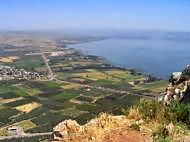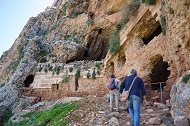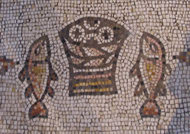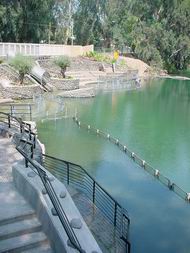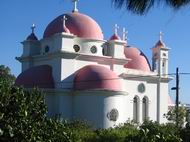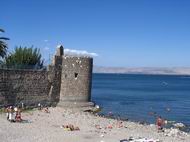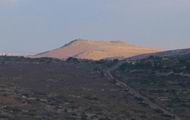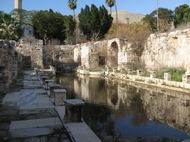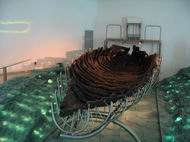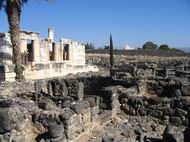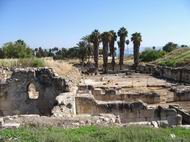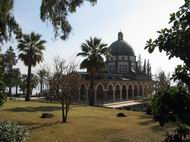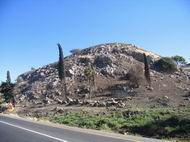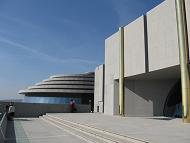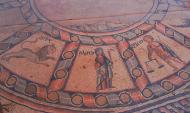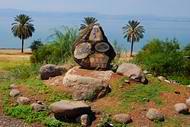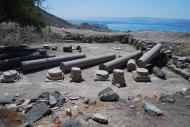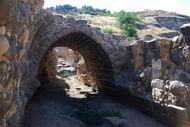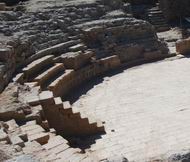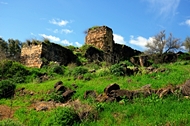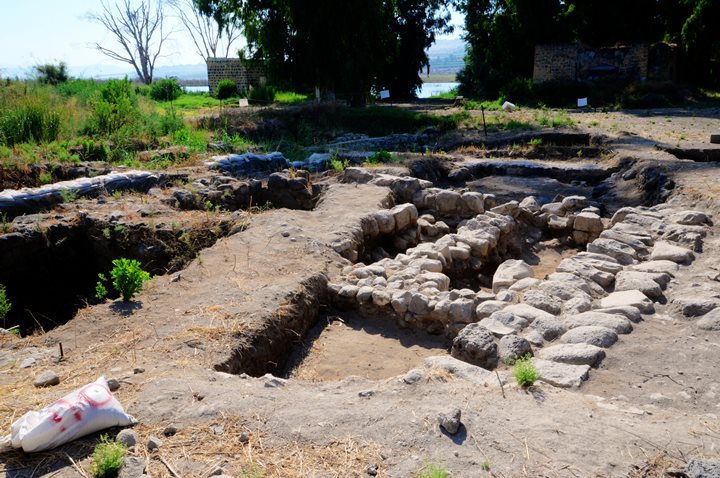This page summarizes the sites that are reviewed in the region of the sea of Galilee.
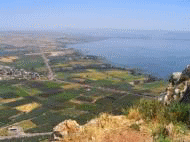
Home > Sites > Sea of Galilee > Sites Gallery
On each site below you can:
- read a short summary (above the picture)
- read the biblical reference (below the picture)
- click on the title to get to the review of that site.
- click on the photo to see the picture at full resolution.
For an overview of the area, click here.
You can also see the list of sites on a map of the region, and use it to navigate among the places.
The Arbel and Nitai cliffs overlook the sea of Galilee, and were used by rebels in ancient times and as a fortress. This is an overview page on the area of Mt. Arbel.
The impressive Arbel cliff overlooks the Sea of Galilee. Its large sets of caves were used for shelter and as a fortress.
- The ruins of a Roman fisherman village, near the Arbel cliffs, on the shores of Sea of Galilee. It was the birthplace of Mary Magdalene.
- Mark 16:9: “Now when Jesus was risen early the first day of the week, he appeared first to Mary Magdalene, out of whom he had cast seven devils”
- Tabcha, or Ein Sheva, is a site on the north-west shore of the Sea of Galilee. In this site there is a Church of the first feeding of the Multitude, with beautiful mosaics of an old church, including the two fish and basket – the symbols of the miracle.
- John 21: 9,10: “As soon then as they were come to land, they saw a fire of coals there, and fish laid thereon, and bread. Jesus saith unto them, Bring of the fish which ye have now caught.”
- Yardenit batismal is a popular site in the south end of the Sea of Galilee. At this site, or to the south of this site, was the place where Jesus was baptized by John the baptist.
- John 1: 28: “This all happened at Bethany on the other side of the Jordan, where John was baptizing.”
OrthodoxChurch, Capernaum
- The Greek Orthodox Church is a charming place in the site of the ancient village of Capernaum.
- Matthew 8:23-24: “And when he was entered into a ship, his disciples followed him. And, behold, there arose a great tempest in the sea, insomuch that the ship was covered with the waves: but he was asleep”.
- Located on the western shore of the sea of Galilee, this city is one of the Holiest Jewish cities for almost 2000 years. It has a long history since it was established in the early Roman period.
- John 6:1: “After these things Jesus went over the sea of Galilee, which is the sea of Tiberias”.
- This site is located west to Tiberias and is located in an extinct volcano. It was a biblical city (maybe Adamah which is referred in Joshua), but is best known for the battle between Saladin and the Crusaders in 1187.
- Joshua 19: 36: “The sixth lot came out to the children of Naphtali … And the fenced cities are … and Adamah, and Ramah, and Hazor,”
- Ruins of a Byzantine complex of cold and warm therapeutic powers springs in the Israeli controlled side of the Yarmuk river. A popular modern complex was built nearby.
- Tell Kinneret is a high hill on the north-west side of the sea of Galilee, where the biblical city of Kinneret once was located. Today the site is used as the water pumps for the National Carrier project.
- Joshua 19, 35: “And the fenced cities are Ziddim, Zer, and Hammath, Rakkath, and Chinnereth,”
- A 1st century AD fishing boat was found in the shores of the sea of Galilee, which may be from Jesus times. It is displayed in a museum in Kibbutz Ginnosar.
- Mark 4: 37: “…he saith unto them, Let us pass over unto the other side. And when they had sent away the multitude, they took him even as he was in the ship. And there were also with him other little ships“
- This village is on the northern side of Sea of Galilee, and was the center of the activities of Jesus and his town during that time. A grand 4th century Ad Synagogue was excavated, which stood over the Synagogue from the time of Jesus.
- Mark 1:21: “And they went into Capernaum; and straightway on the sabbath day he entered into the synagogue, and taught.”
- Ruins of a grand winter palace for the Arabic rulers from Damascus. Built in the 8th C AD near Tell Kinneret.
- Ruins of a Roman/Byzantine town, located above the north side of sea of Galilee, and is referred in the new testament as one of the cities condemned by Jesus.
- Matthew 11 21-22: “Then began he to upbraid the cities wherein most of his mighty works were done, because they repented not: Woe unto thee, Chorazin!…”
- According to the tradition, Mount of Beatitudes is the place where Jesus gave his important sermon on the mountain. A church, monastery, hostel and gardens and farm are located on the hill, above Tabcha.
- Mathew 5: 1-3: “And seeing the multitudes, he went up into a mountain: and when he was set, his disciples came unto him: And he opened his mouth, and taught them, saying, Blessed are the…”
- An old city on the shore of sea of Galilee, located on the ancient road from east to west. Its importance was in the biblical period, and it declined after the establishment of Tiberias.
- The House of the Galilee (Domus Galilaeae) is a modern Christian meeting place for seminars and conventions. It is located on the peak of Mount of Beatitudes, above and north to Capernaum and the sea of Galilee.
- Ruins of a 5th century AD church and monastery at the traditional location of Jesus miracle at Gadarenes – healing the madman, driving out the madman devils into a herd of pigs who then drown in the lake.
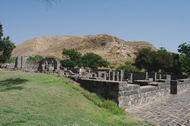
- Mark 5: 13: “And the unclean spirits went out, and entered into the swine: and the herd ran violently down a steep place into the sea…”
- A large Tell located on the south-west side of the Sea of Galilee. One of the most remarkable Early Bronze age sites in Israel. The city also flourished in the Hellenistic (named Philoteria) and Roman/Byzantine periods (named Synnabray).
- Hammat-Tiberias was a walled Canaanite city mentioned in the Bible. It peaked during the Roman/Byzantine periods, and was famous for its healing powers. A number of synagogues were unearthed and reconstructed, including the 5th century Zodiac mosaic.
- Joshua 19: 32, 35: The sixth lot came out for the children of Naphtali…. And their border was … the fortified cities were Ziddim-zer, and Hammath, and Rakkath, and Chinnereth…”
- A walled city during the Bronze and Iron ages, on the north-east side of the Sea of Galilee. According to some Christian traditions – it was the place where Jesus performed the second feeding of the multitude.
- Mark 8 8/9: “…and they took up of the broken meat that was left seven baskets. And they that had eaten were about four thousand…”
- “Job’s spring”, a warm sulfuric spring in Tabcha named after the Biblical figure that was tested by God. A nearby cave was, according to this tradition, the dwelling place of the sick Job.
- Job 38: 25: “Who hath divided a watercourse for the overflowing of waters…”
- The ruins of an ancient city located on the plateau of a diamond shaped mountain by the eastern shores of the Sea of Galilee. The ruins of Hippos are of the Hellenistic, Roman, Byzantine and Umayyad periods. The site is one of the most remarkable archaeological sites in the North of Israel.
- The southern gate and walls of the Roman city include towers, walls, bridge and road.
- Wars III 9 8: “Vespasian… went to the city; upon which the citizens opened to him their gates”
- The Theater of Roman Tiberias is recently excavated and reconstructed. Constructed in the 1st century AD, enlarged in the 2nd century, it had seating capacity of 7,000 people.
- On top of the northern limestone cliff, along the lower Amud stream canyon, is the Skull cave. The cave is also known as Mugharet el-Zuttiyeh (Arabic: “Cave of the Robbers”).
- Sites on the lower Tsalmon stream – flour mills, sheikh tomb, ruins.
- Ruins of a 8th century church located on Mt. Berniki (Berenice), high above the Roman city of Tiberias. Nicknamed ‘the Anchor Church’ based on a relic stone found embedded in its apse.
- A mysterious ritual site and settlement near the Horns of Hattin.
This overview page reviews ancient sites on Mt. Poriya.
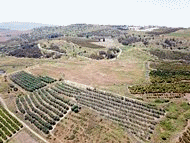
Ruins of the Roman/Byzantine period village, located on the shores of the Sea of Galilee. This could have been Bethsaida, the site of Jesus’ two miracles.
more sites to come…
- For an overview of Sea of Galilee, click here.
- Interactive Map of the sites – click here.
BibleWalks.com – walk with us through the sites of the Holy Land
Sites Navigation: On all featured sites, you can use the navigation aid at the end of the page for proceeding to the next site. The navigation bar takes you through a tour of the sites. At the bottom of each site you can navigate forward or backward, or return back to a full list of all sites in all regions of Israel.
<<<All Sites>>>—next Sea of Galilee site—>>> Arbel
This page was last updated on Mar 12, 2025 (add Arbel cliff)
Sponsored links + sample links to BibleWalks sites:
